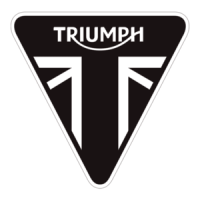
Do you have a question about the Triumph Street Triple Moto2 Edition and is the answer not in the manual?
| Engine Type | Liquid-cooled, 12 valve, DOHC, inline 3-cylinder |
|---|---|
| Engine Capacity | 765 cc |
| Max Torque | 80 Nm @ 9, 500 rpm |
| Transmission | 6-speed |
| Dry Weight | 166 kg |
| Front Brakes | Twin 310 mm floating discs, Brembo Stylema 4-piston radial monobloc calipers |
| Rear Brakes | Single 220 mm disc, Brembo single piston caliper |
| Fuel Tank Capacity | 15 litres |
| Frame | Aluminium beam twin spar |
| Wheels | 17 x 3.5 in (front), 17 x 5.5 in (rear) |
| Front Suspension | Öhlins 43 mm NIX30 upside down forks, adjustable compression and rebound damping |
Identifies the motorcycle models covered by this owner's handbook.
Explains the meaning of warning, caution, and note symbols used throughout the handbook.
Emphasizes the owner's handbook as a permanent part of the motorcycle for safe operation.
Provides essential safety warnings about the motorcycle's intended use and limitations.
Warns about the dangers of gasoline and exhaust fumes, including fire and poisoning risks.
Details the importance and types of protective clothing and helmets for rider safety.
Provides instructions and warnings for safely parking the motorcycle to prevent accidents.
Covers crucial safety aspects of riding, including fatigue, impairment, licensing, and defensive riding.
Explains the electronic throttle system and its operation.
Introduces the two types of instrument displays: LCD/TFT and TFT.
Provides a detailed diagram identifying all elements on the instrument display.
Explains the initial illumination of warning lights and their general meaning.
Details the function and implications of the Engine Management System Malfunction Indicator Light (MIL).
Explains the low oil pressure warning light and the actions to take.
Explains the ABS warning light, its normal operation, and what indicates a malfunction.
Details the Traction Control (TC) indicator light and its function.
Explains how multiple messages are displayed and prioritized.
Lists various warning lights and messages with their indicators and meanings.
Lists indicator lights and messages that may appear during normal operation.
Explains how to access and navigate the Main Menu for motorcycle settings.
Details the configuration options for ABS, MAP, and TC across different riding modes.
Describes the Triumph Shift Assist (TSA) feature and how to enable/disable it.
Explains the functions of the odometer and speedometer.
Explains the tachometer's function of displaying engine speed (RPM).
Explains how the fuel gauge indicates the amount of fuel in the tank.
Describes the coolant temperature gauge and its indication of engine coolant temperature.
Explains how riding modes adjust throttle response and TC settings.
Provides detailed instructions and warnings for selecting riding modes.
Explains how to review active warnings and information messages displayed on the instrument panel.
Explains the TPMS warning light and the actions to take if it illuminates.
Provides information on fuel grade, ethanol content, and engine calibration.
Outlines essential safety instructions for refueling the motorcycle to prevent hazards.
Provides instructions and warnings for filling the fuel tank safely.
Introduces the Cruise Control system and its usage conditions.
Details the conditions and steps required to activate the Cruise Control system.
Explains how to adjust the set speed while Cruise Control is active.
Lists the methods for deactivating the Cruise Control system.
Explains how to resume a previously set speed with Cruise Control.
Explains the function of Traction Control and its limitations.
Explains the TPMS warning light and the actions to take if it illuminates.
Provides warnings and advice on checking tire pressures for safe operation.
Provides essential guidance for the breaking-in period of a new motorcycle.
Lists critical daily checks to ensure safe and reliable motorcycle operation.
Provides instructions on how to safely stop the motorcycle's engine.
Explains the procedure and safety precautions for starting the motorcycle engine.
Details the steps for moving the motorcycle off from a standstill.
Explains the process of shifting gears and associated warnings.
Explains the Triumph Shift Assist system and its operation.
Introduces the braking system and its operation.
Provides essential safety guidelines to observe when braking the motorcycle.
Advises on emergency braking techniques and recommends rider training.
Explains the function of the ABS system and its limitations.
Explains the ABS warning light, its normal operation, and what indicates a malfunction.
Provides warnings and instructions for safely parking the motorcycle in various conditions.
Outlines the steps for parking the motorcycle securely and safely.
Discusses safety and handling considerations for operating the motorcycle at high speeds.
Provides crucial warnings and guidelines for loading the motorcycle safely.
Covers safety guidelines for carrying a passenger, including weight limits and passenger suitability.
Explains the importance of scheduled maintenance and potential consequences of neglect.
Provides a comprehensive table outlining scheduled maintenance tasks based on mileage and time.
Highlights the importance of engine oil for engine, transmission, and clutch function.
Provides instructions and warnings for inspecting the engine oil level.
Details the process and safety precautions for changing the engine oil and filter.
Outlines the steps and torque specifications for changing the engine oil and filter.
Specifies the correct engine oil grade and viscosity for different riding areas.
Emphasizes checking the coolant level daily for efficient engine cooling.
Provides instructions and warnings for inspecting the coolant level in the expansion tank.
Details the procedure and warnings for adjusting the coolant level.
Explains the cable-operated clutch and the importance of checking lever free play.
Emphasizes the importance of drive chain maintenance for safety and wear prevention.
Provides instructions and precautions for lubricating the drive chain.
Explains how to inspect the drive chain and sprockets for wear.
Provides instructions for breaking in new brake pads and discs for optimal performance.
Explains the hygroscopic nature of brake fluid and the need for regular replacement.
Provides instructions and warnings for inspecting and adjusting front brake fluid levels.
Provides instructions and warnings for inspecting and adjusting rear brake fluid levels.
Describes the factory suspension settings and how they affect handling.
Provides information on tubeless tires, valves, and wheel rims.
Warns about the dangers of incorrect tire inflation and provides guidance on checking pressures.
Explains the TPMS system, its installation, and operation.
Contains warnings about battery acid safety and handling.
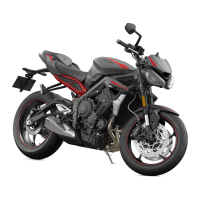
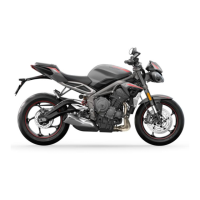
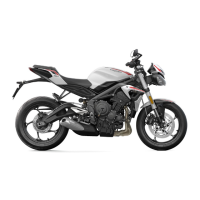

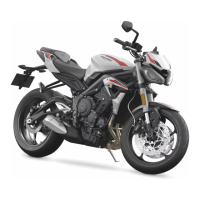



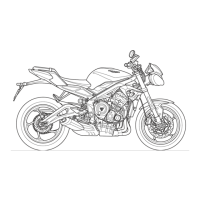
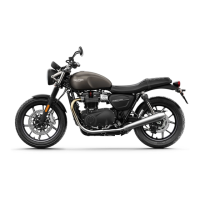

